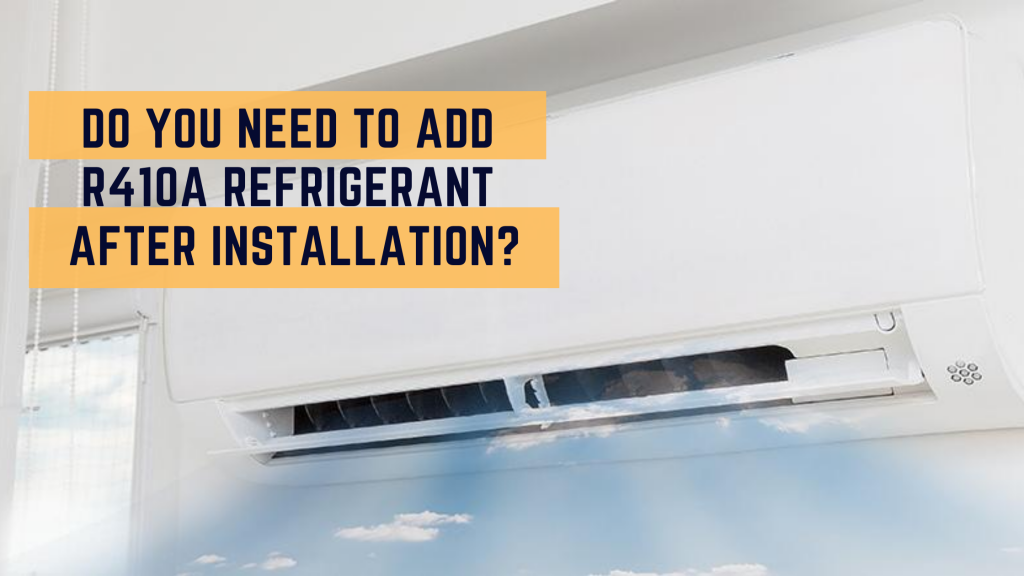Hi! In full disclosure, we may earn money from companies (like Amazon) mentioned in this post if you make a purchase through our links. Thanks in advance for the support!
One thing you should know about how HVAC systems work are refrigerants. This is what air conditioning units rely on to produce cold air for your space. Because of this, some may ask if adding refrigerants like R410a is ideal after a mini-split installation.
To answer this question: No, there is no need to put in additional refrigerant after installation if everything is working as intended.
Additional refrigerant is only necessary if there are refrigerant leaks in the system and if the units were not charged with enough refrigerant during installation. In both cases, adding refrigerants should only be done by qualified professionals.
CALL 1.855.920.1857 FOR HVAC SERVICE
What are refrigerants?
A refrigerant is a compound that can be either in a fluid or gaseous state. Heat is absorbed by refrigerants and cold air is produced once the air is processed between the compressors and evaporators of an HVAC system.
Refrigerants are found within the system’s two sets of copper coils. As hot air is absorbed from the indoors, the refrigerant absorbs the heat and flows into the condenser where it is compressed and pressurized. This turns the gas refrigerant into a high-pressure liquid. A fan continues to blow hot air onto these coils and exhausts the hot air outwards the outdoor unit.
As soon as the liquid refrigerant passes the expansion valve, it evaporates and cools down. Another fan then blows over these coils and releases cold air indoors. The cycle repeats itself until the desired temperature is achieved.
When Is Additional Refrigerant Needed?
An air conditioning system pretty much runs the same cycle as it operates. Air conditioning units are usually charged with enough refrigerant to last its lifetime by the manufacturers. Also, an HVAC expert will charge your system with additional refrigerant during installation if he finds it necessary. Once installed, these lines are sealed and refrigerant should go around the system without getting depleted.
There are only two reasons for you to charge your system with additional refrigerant after installation. One is if there are refrigerant leaks. Two is if your system was not charged with enough refrigerant during installation.
When you find that your air conditioning system is not performing properly, this could be a sign that there isn’t enough refrigerant.
There are a number of ways to tell if there is a leak or if your system needs more coolant.
- It takes a long time to get cold air
- The units are blowing warm instead of cold air
- Your space is not getting cooled at all
- There is an ice buildup on the evaporator coil
- Hissing noise around refrigerant lines
- High energy consumption from your AC units
If you experience any of these things from your system, turn it off and call an HVAC professional.
Having your annual system checkup is also helpful in finding out if your HVAC system has leaks. It is best to find these things sooner so you can be sure that your system is running efficiently and you are getting the best performance from your units.
Can I Add Refrigerant Myself?
No. Adding refrigerants is not a simple construction or electrical job. Do not attempt to add refrigerants by yourself.
An HVAC contractor will be able to locate and repair if there are any leaks in the system before they add refrigerant. Adding more refrigerant into a leaking air conditioning system is a waste of money and is harmful to the environment.
Refrigerants are also toxic and flammable substances. It can be dangerous and harmful to a person’s health and it may even cause fatal accidents in worse cases. Handling refrigerants when you are not properly trained for it runs the risk for fires, asphyxiation, blindness, and others. Unless you are a licensed, qualified professional, please leave this task to the experts.
Besides adding refrigerants properly, HVAC experts also know the proper way to dispose of refrigerant containers.
There are even laws surrounding the proper handling of refrigerants. First, the use of refrigerants is required to be approved by EPA. These substances shouldn’t also be released or vented intentionally to the environment. Second, any service on an HVAC system that involves any kind of payment (monetary and non-monetary) should only be done by certified professionals under section 609 of the CAA. Also, these persons must only use approved equipment in handling refrigerants.
One more thing to consider is that refrigerants are expensive. A system using Freon, a brand of R22 refrigerant, can cost between $75 to around $100 per pound. Wasting refrigerant is not a very good idea.
You can also say goodbye to your warranty if you try to mess around with this yourself.
CALL 1.855.920.1857 FOR HVAC SERVICE
Types of Refrigerants
Over the years, there have been several types of refrigerants used in air conditioning systems. Before 1994, Chlorofluorocarbons (CFCs) were used. This includes the refrigerant R12. These are known to be contributors to the greenhouse effect.
Then, Hydrochlorofluorocarbons (HCFCs), including R22, were used. These are a little safer for the environment than R12. Still, it has been phased out in compliance with the Clean Air Act of 2010. By January 01, 2020, further production of the R22 refrigerant has been stopped. Only the remaining stocks of R22 can be used.
As a replacement to CFCs and HCFCs, Hydrofluorocarbons (HFCs) are now used in HVAC systems including R410A. This refrigerant no longer contains chlorine and is safer for the ozone. HVAC systems that run on R410A are also more energy-efficient and reliable.
What Type of Refrigerant Does My AC Unit Run On?
This typically depends on the manufacturing date, built, and model of your system. Units manufactured before 2010 are probably running on R22.
Newer models should be using R410A. You will usually find the type of refrigerant your air conditioner uses listed in the nameplate of your condenser unit.
Can I Add R410a to a Unit That Runs on r22?
No, refrigerants are integrated into the cooling system. If your air conditioning units come with R22 refrigerants, then you should not mix it with R410A. In fact, it is illegal to do so. The 609 EPA rule states that mixing refrigerants is illegal and any person caught doing so will be subject to heavy fines.
This has been a rising issue because of the recent phasing out of the R22 refrigerants. Supplies are getting scarce and costs are going up. But mixing refrigerants can lead to dangerous risks and breaking down of equipment.
According to Eugene Silberstein, director of technical education and standards of The Esco Institute in Illinois, mixing refrigerants can lead to increased system pressures and temperatures. This results in ineffective compressor cooling, metering device malfunction, compressor damage, and inadequate oil return to the compression.
Final Words
To keep your air conditioning system at peak performance, you need to watch out for potential leaks and refrigerant levels. The best way to keep this in check is to have your system checked regularly by qualified air conditioning experts.
Be on the lookout for refrigerant scams as well. Lower refrigerant levels could be a sign of leaks. If you are advised to have your units charged with additional refrigerants, make sure that the problem is addressed from its root cause which in most cases is a refrigerant leak.

